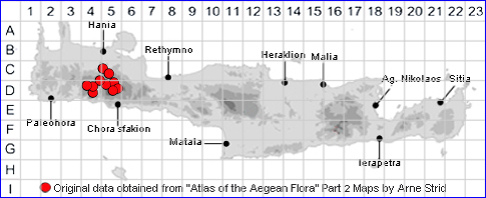
SPECIES DESCRIPTION
ARENARIA CRETICA
Family and Genus:- See- CARYOPHYLLACEAE/Subgen. ARENARIA
Common Name:- None
Homotypic Synonyms:- None
Meaning:- Arenaria (L) Sand-dweller.
Cretica (L) From Crete, Cretan.
General description:- Densely caespitose, perennial.
Stems:-
1) 2-10 cm. slender, fragile usually glandular-pubescent only in inflorescence.
Leaves:-
1) 3-10 mm, crowded, oblong-elliptical or oblanceolate, rather obtuse. glabrous or
glandular-pubescent.1-veined.
Flowers:-
1) Inflorescence,1- to 5-flowered, usually corymbose stems, 1-3 times as long as
the sepals.
2) Sepals, 2·5-5 mm. oblong or oblanceolate, obtuse or subacute. veinless,
keeled at the base. glandular-pubescent.
3) Petals, 2 or more times as long as the sepals, white.
Fruit:-
1) Capsule, slightly exceeding the sepals. ovoid.
2) Seeds, 0.8-0.9 mm. with low obtuse tubercles.
Key features:-
1) Sepals, and sepals obtuse or subacute.
2) Capsule, slightly exceeding the sepals.
3) Leaves, acute or mucronate.
Habitat:- Crevices of limestone cliffs, 1400-2200 m.
Distribution:- Scattered in mountains Taigetos northwards, extending just across
the borders to Albania. Rare on Crete known only from the Lefka Ori mountain
range.
Flowering time:- June-Aug.
Photos by:- Fotis Samaritakis
